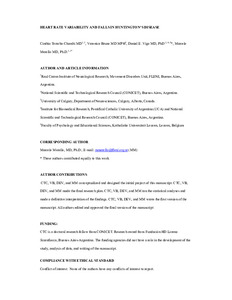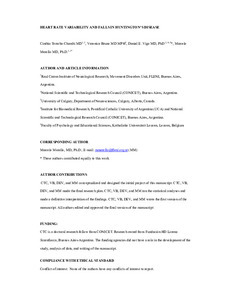Por favor, use este identificador para citar o enlazar este ítem:
https://repositorio.uca.edu.ar/handle/123456789/10351| Título: | Heart rate variability and falls in Huntington’s disease | Autor: | Terroba-Chambi, Cinthia Bruno, Verónica Vigo, Daniel Eduardo Merello, Marcelo |
Palabras clave: | ENFERMEDAD DE HUNTINGTON; SISTEMA NERVIOSO AUTONOMO; FRECUENCIA CARDIACA; TRASTORNOS DEL MOVIMIENTO | Fecha de publicación: | 2020 | Editorial: | Springer Nature | Cita: | Terroba-Chambi, C., et al. Heart rate variability and falls in Huntington’s disease [en línea]. Postprint de artículo publicado en Clinical Autonomic Research. 2020. doi:10.1007/s10286-020-00669-2. Disponible en: https://repositorio.uca.edu.ar/handle/123456789/1035 | Resumen: | Abstract: Purpose: Huntington's disease (HD) patients have a high prevalence of falls. Autonomic nervous system dysfunction has been reported from the early stages of the disease. There is no evidence analyzing the relationship between heart rate variability (HRV) and falls in this population. This research aimed to evaluate the relationship between HRV and falls in HD. Methods: HD patients enrolled in a prospective study of Fear of Falling and falls were assessed using short-term HRV analyses and blood pressure measures in resting and standing states. Time-frequency domains and nonlinear parameters were calculated. Data regarding falls, the risk of falling (RoF) and disease-specific scales were collected at baseline and six-month follow-up. Results: Twenty HD patients were recruited. 35% of HD patients reported at least one fall (single fallers) and, 65% reported two or more falls (recurrent fallers) in the previous 12-months. At baseline, recurrent fallers had lower RMSSD-resting (root-mean-square-of-the-RR), higher LF/HF ratio (low/high frequency) in both states, and higher DFA-α1 parameter (short-term-detrended-fluctuation-analyses) in both states. This association was similar at a six-month follow-up for recurrent fallers showing lower RMSSD-resting and higher LF/HF-standing ratio than single fallers. Significant correlations were found between the number of falls, RMSSD-resting, and LF/HF-standing ratio. No differences were found between recurrent and single fallers for any blood pressure measures. Conclusions: The observed HRV pattern is consistent with a higher sympathetic prevalence associated with a higher RoF. Reduced parasympathetic HRV values predict being a recurrent faller at six-months of follow-up, independently of orthostatic phenomena in this population. | URI: | https://repositorio.uca.edu.ar/handle/123456789/10351 | ISSN: | 0959-9851 (impreso) 1619-156 (online) |
Disciplina: | MEDICINA | DOI: | 10.1007/s10286-020-00669-2 | Derechos: | Acceso abierto. 12 meses de embargo | Fuente: | Postprint de artículo publicado en Clinical Autonomic Research. 2020 |
| Aparece en las colecciones: | Artículos |
Ficheros en este ítem:
| Fichero | Descripción | Tamaño | Formato | |
|---|---|---|---|---|
| heart-rate-variability-falls.pdf | 266 kB | Adobe PDF |  Visualizar/Abrir | |
| heart-rate-variability-falls.pdf.jpg | 16,21 kB | JPEG |  Visualizar/Abrir |
Visualizaciones de página(s)
165
comprobado en 27-abr-2024
Descarga(s)
438
comprobado en 27-abr-2024
Google ScholarTM
Ver en Google Scholar
Altmetric
Altmetric
Este ítem está sujeto a una Licencia Creative Commons

